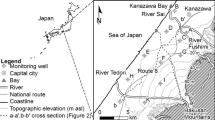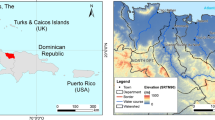Abstract
Groundwater flow models are applied to a large variety of hydrogeological conditions in different aquifer types, in order to simulate the groundwater flow of the investigated system. This paper aims to present the application of a groundwater flow model for the simulation of a sedimentary aquifer, located in Northern Greece. The simulation involves the period between April 2003 and April 2004, and the model is divided into two distinct stress periods, each containing two different time steps. The simulation of the aquifer is found to be satisfactory, conclusion which is based on both graphical as well as arithmetical verifications. The groundwater flow simulation was achieved by the application of the MODFLOW code.


























Similar content being viewed by others
References
American Society of Civil Engineers, ASCE (1972). Groundwater management manual, Engineering. Practice 40, New York, pp 216.
Baird, K. J., Stromberg, J. C., & Maddock, T., III. (2005). Linking riparian dynamics and groundwater: An ecohydrologic approach to modeling groundwater and riparian vegetation. Environmental Management, 36(4), 551–564.
Binet, S., Jacques, M. J., Bertrand, C., Guglielmi, Y., & Cova, R. (2006). Estimation of quantitative descriptors of northeastern Mediterranean karst behavior: Multiparametric study and local validation of the Siou-Blanc massif (Toulon, France). Hydrogeology Journal, 14(7), 1107–1121.
Daskalaki, P., & Voudouris, K. (2008). Groundwater quality of porous aquifers in Greece: A synoptic review. Environmental Geology, 54, 505–513.
Diamantis, Ι., Petalas, C., Tzevelekis, Th., Pliakas, F. (1994). Investigation for the possibility of water supply of coastal settlements of Thrace from coastal aquifers. Technical Report for the Region of Eastern Macedonia and Thrace, Greece, 4 volumes, pp 393.
Diamantopoulou, P., & Voudouris, K. (2008). Optimization of water resources management using SWOT analysis: The case of Zakynthos Island, Ionian Sea, Greece. Environmental Geology, 54, 197–211.
Don, N. C., Araki, H., Yamanishi, H., & Koga, K. (2005). Simulation of groundwater flow and environmental effects resulting from pumping. Environmental Geology, 47(3), 361–374.
Eusuff, M. M., & Lansey, K. E. (2004). Optimal operation of artificial groundwater recharge systems considering water quality transformations. Water Resources Management, 18(4), 379–405.
Kallergis, G. (2000). Applied environmental hydrogeology (2nd ed., Vol. 2, p. 345). Athens: Technical Chamber of Greece.
Kallergis, G. (2001). Applied environmental hydrogeology (2nd ed., Vol. 3, p. 432). Athens: Technical Chamber of Greece.
Kallioras, A. (2008). Groundwater resources management of aquifers subjected to seawater intrusion regime. The case of western coastal plain of the Prefecture of Rhodope. Doctoral dissertation submitted to the Department of Civil Engineering, Democritus University of Thrace, Xanthi, Greece. pp 333. (In Greek).
Kallioras, A., Pliakas, F., & Diamantis, I. (2006a). Conceptual model of a coastal aquifer system in northern Greece and assessment of saline vulnerability due to seawater intrusion conditions. Environmental Geology, 51(3), 349–361.
Kallioras, A., Pliakas, F., Diamantis, I., & Emmanouil, M. (2006b). Application of Geographical Information Systems (GIS) for the management of coastal aquifers subjected to seawater intrusion. Journal of Environmental Science and Health, Part A: Toxic/Hazardous Substances and Environmental Engineering, A41(9), 2027–2044.
Kallioras, A., Pliakas, F., Diamantis, I., & Kallergis, G. (2006c). Seawater intrusion and management of coastal aquifers in Greece. The case study of Rhodope western coastal aquifer, International Water Association, IWA, 10th International Conference on Diffuse Pollution, Istanbul, Turkey, 18–22 September 2006 (CD of Proceedings, Manuscript E218).
Lambrakis, N., & Kallergis, G. (2001). Reaction of subsurface coastal aquifers to climate and land use changes in Greece: Modelling of groundwater refreshening patterns under natural recharge conditions. Journal of Hydrology, 245, 19–31.
Long-cang, S., & Xun-hong, C. (2002). Simulation of water quantity exchange between groundwater and the Platte River water, central Nebraska. Journal of Central South University of Technology, 9(3), 212–215.
Martinez, S. E., & Carrillo-Rivera, J. J. (2006). Socio-economic constraints of groundwater in Capital La Rioja, Argentina. Environmental Geology, 49(6), 875–886.
Mercurio, J. W., Beljin, M. S., Barry, J., & Maynard, J. (1999). Groundwater models and wellfield management: A case study. Environmental Engineering and Policy, 1(3), 155–164.
Palma, C. H., & Bentley, L. R. (2007). A regional-scale groundwater flow model for the Leon-Chinandega aquifer, Nicaragua. Hydrogeology Journal, 15(8), 1457–1472.
Panagopoulos, G., Lambrakis, N., Tsolis-Katagas, P., & Papoulis, P. (2004). Cation exchange processes and human activities in unconfined aquifers. Environmental Geology, 46, 542–552.
Petalas, C. (1997). Analysis of aquifer systems in the heterogeneous coastal part of prefecture of Rhodope. Doctoral Dissertation. Department of Civil Engineering, Democritus University of Thrace, Xanthi, Greece, pp 288.
Pliakas, F. (1998). Investigation for the application of appropriate methods of artificial recharge in heterogeneous alluvial aquifer formations. Applications in aquifers of plain part of Xanthi, Greece, Doctoral Dissertation, Civil Engineering Department, Democritus University of Thrace, Xanthi, Greece, pp 253.
Pliakas, F., Petalas, C., Diamantis, I., & Kallioras, A. (2005a). Modeling of groundwater artificial recharge by reactivating an on old stream bed. Water Resources Management, 13(9), 279–294.
Pliakas, F., Kallioras, A., & Giougis, I. (2005b). Investigations for the verification of groundwater flow model in plain area of Xanthi, Greece. In Proceedings of the 7th Hydrogeological Conference of the Greek Hydrogeological Committee of the Geological Society of Greece and the 2nd Middle and East Mediterranean Workshop on Fissured Rocks hydrology (IAH, International Association of Hydrogeologists), 4–6/10/2005, Athens, Greece, pp. 429–436, [in Greek].
Reichard, E. G., & Theodore, A. J. (2005). Assessment of regional management strategies for controlling seawater intrusion. Journal of Water Resources Planning and Management, ASCE, 131(4), 280–291.
Rejani, R., Jha, M. K., Panda, S. N., & Mull, R. (2008). Simulation modeling for efficient groundwater management in Balasore Coastal Basin, India. Water Resources Management, 22(1), 23–50.
Rodríguez, L. B., Cello, P. A., & Vionnet, C. A. (2006). Modeling stream–aquifer interactions in a shallow aquifer, Choele Choel Island, Patagonia, Argentina. Hydrogeology Journal, 14(4), 591–602.
Saeed, M. M., & Bruen, M. (2004). Simulation of hydrosalinity behavior under skimming wells. Irrigation and Drainage Systems, 18(2), 167–200.
Shammas, M. I., & Jacks, G. (2007). Seawater intrusion in the Salalah plain aquifer, Oman. Environmental Geology, 53, 575–587.
Stamatakis, G. (1992). Investigation of water potential of Rhodope Prefecture, Undergraduate Thesis, Civil Engineering Department, Democritus University of Thrace, pp. 110.
Szucs, P., Madarasz, T., & Civan, F. (2009). Remediating over-produced and contaminated aquifers by artificial recharge from surface waters. Environmental Modeling and Assessment, 14, 511–520. doi:10.1007/s10666-008-9156-4.
Wang, S., Shao, J., Song, X., Zhang, Y., Huo, Z., & Zhou, X. (2008). Application of MODFLOW and geographic information system to groundwater flow simulation in North China Plain, China. Environmental Geology, 55, 1449–1462. doi:10.1007/s00254-007-1095-x.
Wu, Q., & Zhou, W. (2008). Prediction of inflow from overlying aquifers into coalmines: A case study in Jinggezhuang Coalmine, Kailuan, China. Environmental Geology, 55, 775–780. doi:10.1007/s00254-007-1030-1.
Acknowledgements
The first author would like to express his thanks to Professor Emeritus George Kallergis for his support and his very interesting suggestions and recommendations regarding the hydrogeological assessment of the study area. All satellite images (basemaps) of the present research paper are adapted from Google Earth© 2005.
Author information
Authors and Affiliations
Corresponding author
Rights and permissions
About this article
Cite this article
Kallioras, A., Pliakas, F. & Diamantis, I. Simulation of Groundwater Flow in a Sedimentary Aquifer System Subjected to Overexploitation. Water Air Soil Pollut 211, 177–201 (2010). https://doi.org/10.1007/s11270-009-0291-6
Received:
Accepted:
Published:
Issue Date:
DOI: https://doi.org/10.1007/s11270-009-0291-6




